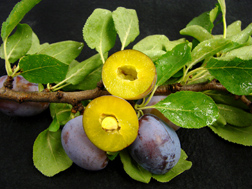Plums Without Pits
|
|
How great would it be to sink your teeth into a perfectly ripe plum without having to worry about how to inconspicuously dispose of that pit?
Molecular biologists Chris Dardick and Ann Callahan and Prunus breeder Ralph Scorza are looking for the genes that control pit formation in plums—the first step in blocking their development. The research team works at the ARS Appalachian Fruit Research Station in Kearneysville, West Virginia.
Fruit pits consist of the seed and the hard woody material, or stone, surrounding the seed. The stone is considered a nuisance by consumers and processors. “Pitless fruit varieties would be a premium product that could provide higher income for growers and could increase consumption of these nutritious foods,” says Dardick. It could also save fruit processors money, because pit removal and disposal are costly practices.
The Quest for Pitless Fruit
The idea of pitless, or stoneless, fruits is not new. In the early 1900s Luther Burbank, a prolific horticulturist, crossed a partially stoneless wild plum with California French prune varieties. These crosses led to commercial-quality fruit that almost completely lacked the stone, but still contained the seed. Burbank’s work demonstrates that stoneless fruit can still hang onto the tree, reach appropriate size, and attain commercial quality.
“Since Burbank’s death in 1927, we’ve only been able to find three sources of his stoneless plums in germplasm repositories, and it’s not yet clear if they are all the same,” says Dardick. “Most of Burbank’s stoneless varieties have been lost, but we have some of the trees from the repositories growing in our orchard. We have initiated crosses with these trees to start a new breeding program, but the trees are still immature and therefore do not yet produce fruit. In addition, we engineered Burbank’s stoneless variety with an early-flowering trait that will greatly speed up the breeding program. The resulting fruit has remarkably little stone tissue, but further improvements are still needed to make it edible.”
A Look to the Future
To create truly pitless fruit, it is necessary to eliminate both the stone and the seed inside. “We have begun projects to address both issues. These take advantage of both traditional breeding—using Burbank’s plums—and genetic engineering,” says Dardick.
“Our group discovered that a set of genes necessary for production of lignin, a material for stone formation, is rapidly turned on specifically in stone tissue—not the flesh or skin—just before hardening, and then quiets down just as quickly after the stone hardens,” says Dardick. “The goal is to establish techniques to stop the genes’ activity and prevent hardening.”
In 2008, another team member, Chinnathambi Srinivasan, a plant transformation specialist, genetically engineered early-flowering plums that produce fruit in 6 months instead of the usual 4-5 years. Srinivasan now has several plum lines that are being further developed for experimental use. Early flowering will substantially shorten the time it takes to test the strategies.
“If it’s successful, we hope the research can be applied to other stone fruits, such as cherries, peaches, nectarines, and apricots,” Dardick says.
While pitless stone fruits won’t be on store shelves anytime soon, the study of plum stones may also have important implications for forestry or biofuel crops—in which lignin is a key source of fiber strength and energy storage. Manipulating lignin levels in plants has proven difficult. New studies suggest that plum stones contain extremely high levels of lignin. Understanding how they accumulate so much lignin may open up new opportunities for enhancing wood properties in trees or developing high-energy-density biofuel crops.—By Sharon Durham, Agricultural Research Service Information Staff.
This research is part of Plant Genetic Resources, Genomics, and Genetic Improvement, an ARS national program (#301) described on the World Wide Web at www.nps.ars.usda.gov.
Chris Dardick is with the USDA-ARS Appalachian Fruit Research Station, 2217 Wiltshire Rd., Kearneysville, WV 25430; phone (304) 725-3451, fax (304) 728-2340.
"Plums Without Pits" was published in the April 2009 issue of Agricultural Research magazine.







